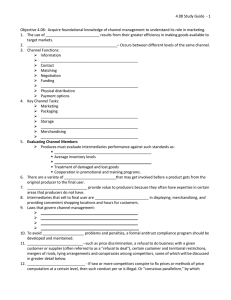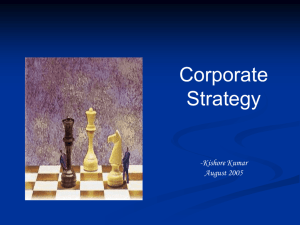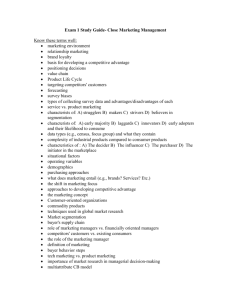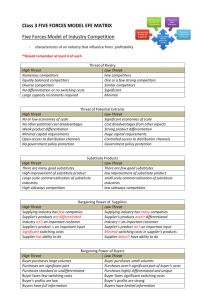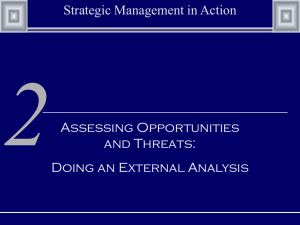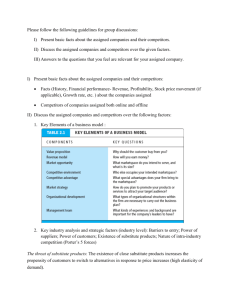Things I should have learned in marketing
advertisement
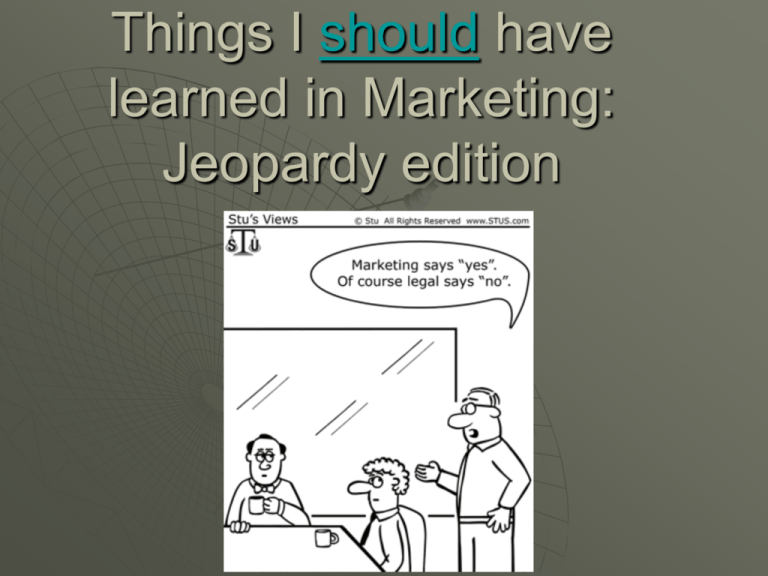
Things I should have learned in Marketing: Jeopardy edition • serve as a guide for what the organization wants to accomplish. • be “market-oriented” rather than “product-oriented”. • be neither too narrow, nor too broad. • fit with the market environment. • be motivating. What is a mission Statement? Should be specific Measurable Have a Time line What is an objective? An SBU with a high relative market share in a market that has stopped growing What is a Cash Cow Figure 2-2: Growth-Share Matrix I should Divest or Harvest What is when my SBU is a DOG? This is the riskiest of the generic growth strategies What is diversification? Figure 2-3: Product / Market Expansion Grid Dividing up a heterogeneous market into multiple user groups What is segmenting? The group of consumers that you are trying to sell your products to What is your target market? Creating the perception in the mind of the consumers that your product is the ideal product for them What is product positioning? The variables that the marketer controls, sometimes known as the 4ps What is the marketing mix? This element of the marketing mix deals with communication What is promotion? Branding and Packaging issues are part of this element of the Marketing mix What is Product? Distribution and logistics are part of this element of the marketing mix What is Place? Figure 2-6: Managing the Marketing Effort An advantage over competitors gained by offering consumers greater value than competitors offer What is competitive advantage? Would have accepted core competency The process of identifying key competitors; assessing their objectives, strategies, strengths and weaknesses, and reaction patterns; and selecting which competitors to attack or avoid. What is competitive analysis Concentrating on competitors so much that you ignore other issues What is competitor Myopia? Using other companies to establish industry standards What is benchmarking? Those companies that compete in the same way in the same industry What is a strategic group? Good or bad competitors The generic strategy of Creating a highly differentiated product line and marketing program What is differentiation Competitive Strategies Basic Winning Competitive Strategies: Porter • Overall cost leadership Lowest production and distribution costs • Differentiation Creating a highly differentiated product line and marketing program • Focus Effort is focused on serving a few market segments 18- 41 The value discipline of superior value via price and convenience What is operational excellence? Basic Competitive Strategies: Value Disciplines • Operational excellence Superior value via price and convenience • Customer intimacy Superior value by means of building strong relationships with buyers and satisfying needs • Product leadership Superior value via product innovation Figure 18-3: Hypothetical Market Structure Product proliferation What is a market leader strategy designed to protect market share? Expanding the total demand • Finding new users • Discovering and promoting new product uses • Encouraging greater product usage Protecting market share • Many considerations • Continuous innovation Expanding market share • Profitability rises with market share Option 1: challenge the market leader • High-risk but high-gain • Sustainable competitive advantage over the leader is key to success Option 2: challenge firms of the same size, smaller size or challenge regional or local firms Full frontal vs. indirect attacks What are market challenger strategies? Content to not rock the boat and to rely on “me too” products Follow the market leader • Focus is on improving profit instead of market share • Many advantages: Learn from the market leader’s experience Copy or improve on the leader’s offerings Strong profitability Wants to be the dullest story in America Who is the Dial Corporation? Targets small lucrative markets What is a market nicher? Serving market niches means targeting subsegments Good strategy for small firms with limited resources Offers high margins Specialization is key •By market, customer, product, or marketing mix lines Game playing industry Nintendo a. a. Wii hyperlink Microsoft b. a. Xbox 360 Sony c. a. Play Station 18- 55 18- 56 Threat of New Entry the existence of barriers to entry economies of product differences brand equity switching costs capital requirements access to distribution absolute cost advantages learning curve advantages expected retaliation government policies 18- 57 Competitive Rivalry number of competitors rate of industry growth intermittent industry overcapacity exit barriers diversity of competitors informational complexity and asymmetry brand equity fixed cost allocation per value added level of advertising expense 18- 58 Supplier Power supplier switching costs relative to firm switching costs degree of differentiation of inputs presence of substitute inputs supplier concentration to firm concentration ratio threat of forward integration by suppliers relative to the threat of backward integration by firms cost of inputs relative to selling price of the product 18- 59 Buyer Power 18- 60 buyer concentration to firm concentration ratio bargaining leverage buyer volume buyer switching costs relative to firm switching costs buyer information availability ability to backward integrate availability of existing substitute products buyer price sensitivity price of total purchase Threat of Substitution buyer propensity to substitute relative price performance of substitutes buyer switching costs perceived level of product differentiation 18- 61

